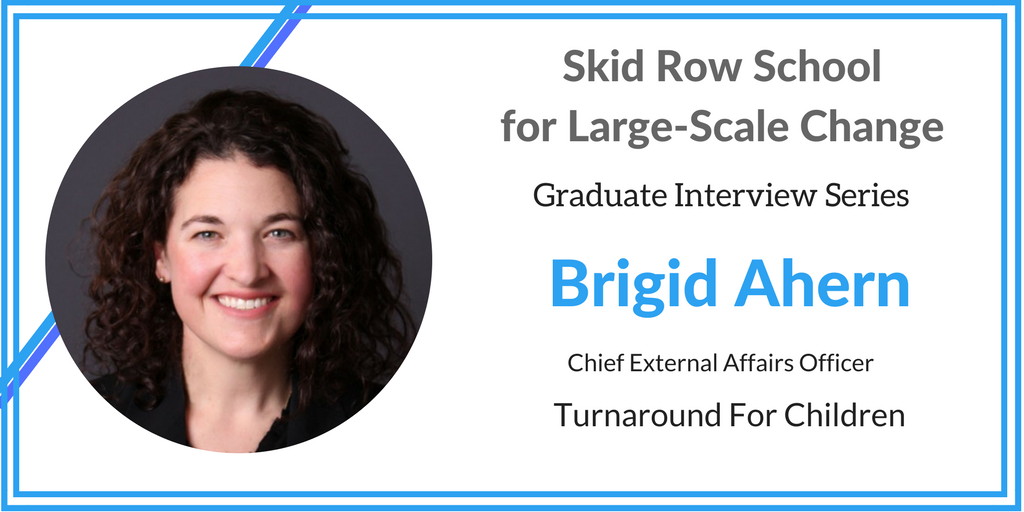
Meet Brigid Ahern. Brigid is the Chief External Affairs Officer for Turnaround for Children. She oversees the Communications, Development, Policy and Systemic Impact teams and serves as the driving force behind efforts to increase stakeholder engagement to fulfill the organization’s mission of transforming high-poverty schools.
What is the core/heart of Turnaround for Children’s intervention?
The heart of Turnaround’s intervention is the deep belief in the potential in every child. Our vision is for every student to attend a school that puts them on a path to the life they choose. The core of our intervention is the translation of science to practice.
Science tells us so much about how children develop as learners, the impact of adversity on that development, and about the power of context – of environment and relationships – to shape children’s development. Turnaround is a leader in translating this science into practice – so much of the science is locked in academia, and we’re trying to change that. We partner with schools and districts to diagnose their school environments and implement tools and strategies that accelerate student development and academic achievement, in ways that integrate with their vision and goals.
We like to quote Don Berwick “Some is not a number, soon is not a time.” What is your current 18 to 36 month aim?
I’m laughing because this quote is on my wall at work, but our 18-36 month aim is very much in development. The truth is that our original aim did not take into account the integrated nature of our intervention nor was it appropriately “chunked.”
Our current aim for the next three years is to increase the number of schools in this country that acknowledge and address the impact of adversity through an integrated approach. Where we struggle is that our goal was a very small number of schools. We are learning that our impact is having far-reaching effects, which are very hard to measure. We have had to change the number of schools, but that number depends on how integrated our programs have to be in order to “count.”
We know that by the end of the 2019-20 school year, we want to build a pipeline of 8 – 10 districts, CMOs (Charter Management Organization), or other organizations who have acknowledged the impact of adversity on learning and want to work with us to address it. Even if we only ultimately work with one or two, getting to this stage means we would have built enough awareness about the impact of adversity and the science of learning that more than 100 schools would be taking action to address it because of our efforts.
What was the most important take-away for you from the Skid Row School for Large-Scale Change?
There were several takeaways. The first is that you have to be creative and flexible, but you don’t have to make all of this up from scratch. Also, that the method helps you put one foot in front of the other and ask the right questions. I was also struck at how incredibly different the organizations that were in attendance, but how applicable the THINKING was from one to the other. I remember sitting with Kate Hurley (Founder of the Million Cat Challenge) at one point and thinking, “our aims could not be more different” and ultimately we were struggling with the exact same issue. It was fascinating just how transferable the work was from one context to the other.
Lastly, I learned how crystal clear you have to be in WHAT you are scaling in order to scale it. It sounds ridiculously obvious, but it’s really hard to do. There is so much possibility and applicability for the work that we do that it’s hard to not get excited about all the places you could leverage the science of learning and development. You have to know exactly what change you want to make in order to pick the right channels.
What advice would you give a new leader who really wants to spread/scale their work?
Be as clear as you possibly can about what you want to be different in the world and continually clarify it. As the leader, you’re the one who sees it clearest. Everyone around you is going to tell you all of these different things, but you have to have the picture of what you want in your head. You are the owner of this new reality. Everyone else has something to offer you to get you there, but at the beginning you are likely the one who sees it the clearest. I can see a world where the potential of each student is seen, valued, and given what they need to succeed. Now we just have to organize ourselves to get to that place.
I can see a world where the potential of each student is seen, valued, and given what they need to succeed. ~Brigid Share on XWhat gets you motivated and out of bed every morning?
My family. I have 4 year old twins, and their potential is limitless. They speak more languages than I do, tell jokes, and are just these complex tender beings that are sponges. It’s a constant reminder that every single child on earth has that kind of potential if we adults – not just parents, but teachers, principals, school support staff, afterschool leaders – get it right. There is nothing more important..
How do you recharge your batteries and take care of yourself?
I wish I did a better job of this. Having kids and a job like this has made me hypered-scheduled, so when my husband and I have time together, we try not to plan it. We never plan our nights out. We just start out the front door and walk. We’ve walked all over the five boroughs and just talk. We don’t do it as often as we like, but it’s a release from the hyper-planning of every minute. I also love to read fiction and try to do it every single night. Stories are the super highway to the heart.
If you had three wishes for humanity and the planet, what would they be?
Working for Turnaround has helped me crystallize this. It’s about cherishing both the individual people and the context in which they thrive. For an individual, what I mean is that each individual is important and has something to offer, and we must start with kindness, compassion and respect and build toward peace. I have never been more convinced that the key to everything is relationships. What I mean by context is two things: the actual planet –clean water, clean air – and the systems that support humanity –education, medical care, government –to be built to care for individuals. We have learned so much about this relationship between the individual and his or her environment –and each day we learn more about how to make systems that work for all of us. We need to continue to learn, but more than anything we need to get to work.
